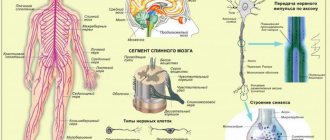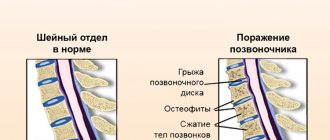Many people have headaches. It can be pulsating, aching, localized on one side of the head, in the frontal part, or maybe in the back of the head and neck. The last two characteristics may be a sign of a condition such as posterior cervical sympathetic syndrome.
Posterior cervical sympathetic syndrome is not a disease, but a set of symptoms that manifest as pain in the back of the head, neck and upper extremities.
The human spine is very complex in structure. Each department is responsible for specific body parts and organs. In the transverse processes of the cervical spine there are openings where a vital paired vessel, the vertebral artery, passes. The nerve of the same name also passes here, which seems to entwine the vertebral artery. Therefore, when irritated, the nerve is able to “give a command” to narrow the artery, which will cause various symptoms.
Description and causes of the disease
Posterior cervical sympathetic syndrome is also called “Barré-Lieu syndrome” - it was these neurologists who first drew attention to this disease and described it in their works. Its main cause is compression of the roots of the spinal nerves located around the vertebral artery. They are located at the level of the 1st, 2nd and 3rd cervical vertebrae, so the disease is often associated with their anomalies. As a result of mechanical effects on nerves and plexuses, including the superior cervical sympathetic node, vasoconstriction occurs. During an attack, patients experience spasm of the vertebral artery and its branches, up to the posterior branches of the cerebral arteries. This condition leads to insufficient blood supply to the brain and oxygen starvation of nerve cells.
For frequent migraines, it is recommended to conduct a full examination of the spinal column, especially its cervical region. The following abnormalities may be detected on x-rays, as well as on CT or MRI results:
- osteochondrosis - wear and thinning of intervertebral cartilage, as a result of which the clearance between the vertebrae decreases;
- spondylosis is a pathology that is manifested by the fusion of two adjacent vertebrae;
- osteophytes - bone growths on the surfaces of the vertebrae that protrude outward and put pressure on the roots of the spinal nerves;
- various neoplasms in the cervical spine;
- cervical lymphadenitis - inflammation and enlargement of the lymph nodes;
- cervical arachnoiditis is a dangerous disease in which inflammation of the arachnoid membrane of the brain is observed;
- stenosis (narrowing of the lumen) of the vertebral artery.
Any of the causes of Barre-Lieu syndrome requires diagnosis and proper treatment, in some cases surgery is prescribed. After eliminating the main factor that caused compression of the nerve roots, the pain stops.
When blood circulation in the brain tissue deteriorates, nerve cells undergo necrosis (die). This can cause a stroke, so doctors strongly do not recommend enduring headaches - it is important to restore vascular conductivity as quickly as possible.
Provocateurs of cervical migraine
This disease can be caused by several reasons, but in medical practice they are divided into 2 main categories:
- Vertebrogenic
- Nonvertogenic
The following pathologies of the spinal column are classified as vertibrogenic:
- congenital vertebral pathology
- injury
- osteochondrosis of the cervical vertebrae
- instability of the cervical spine
- idiopathic problems
Nonvertogenic causes include:
- whiplash injuries
- muscle spasm
This is not a complete list of reasons that provoke cervical migraine. Here we name only the most common of all, which in recent years have brought the patient to the clinic for examination. If you correctly understand the causes of the pathology, you can diagnose the syndrome in a timely manner.
A timely and correct diagnosis, as well as an adequate approach to treatment, will help interrupt the development of the syndrome.
At the initial stage of development, cervical migraine manifests itself periodically. As a rule, this is a strong and sharp pain in the back of the head, which can migrate to the forehead and temples, and after some time recedes.
Depending on the degree of development, the symptomatic syndrome is divided into two categories:
- Reversible. It is characterized by paroxysmal headaches and some minor manifestations of the disease. Based on the name, it can be understood that adequate treatment at this stage of the disease leads to a complete recovery of the patient.
- Irreversible. It is characterized by a constantly narrowed state of blood vessels and progression of accompanying symptoms. The patient experiences headaches frequently and more intensely.
Symptoms of the disease
It is impossible to miss an attack of posterior cervical sympathetic syndrome. It occurs suddenly or intensifies gradually, but always leads to an acute headache. This pathology is characterized by the “removing the helmet” symptom: when asked to show the epicenter of pain, the patient moves his hand from his forehead to the back of his head. The pain is cutting, throbbing, and can spread to the back of the head or cover its entire surface. Determining the source of pain is often difficult - it is diffuse and not concentrated in one point, it radiates to the frontal lobe, and can affect the eyes and the space behind them.
In addition to headaches, Barré-Lieu syndrome can manifest itself with other symptoms:
- nausea and vomiting;
- discomfort in the cervical spine - head movements are accompanied by crunching, clicking, pain, and the amplitude in this area is noticeably reduced;
- feeling of a lump in the throat;
- attention disorders, possible memory lapses;
- impaired coordination of movements and temporary deterioration of orientation in space;
- tinnitus, ringing and other extraneous sounds;
- deterioration of vision, the appearance of black spots and other obstacles in front of the eyes, possible slight doubling of objects, rapid visual fatigue - these symptoms are not associated with organic disorders of the organ of vision;
- chills, sweating, increased body temperature.
Posterior cervical sympathetic syndrome is a dangerous disorder. Its symptoms can appear in connection with physical or mental stress, weather changes, or occur for no apparent reason. Most often they are associated with prolonged tension in the cervical spine or this area being in an uncomfortable position. During an attack, the patient loses the ability to concentrate on tasks, so his performance is significantly reduced. In addition, there is increased irritability, fatigue and other symptoms.
Therapeutic massage remains one of the reliable ways to get rid of spasms and restore vascular conductivity, but it must be done by a specialist
At the first manifestations of this disease, you should contact a rheumatologist to determine its cause and receive recommendations for treatment. In advanced cases, migraines can last up to several days, and during this time the brain experiences a lack of oxygen. Intense headaches can cause fainting and even provoke a stroke - an acute disorder of cerebral circulation.
How does pathology manifest itself?
Due to the fact that the cervical spine innervates many different parts of the body, the manifestations of the syndrome can be completely different. But there is a special one that characterizes the probable presence of damage to the vertebral artery - a symptom of “cervical migraine”. This is pain that is localized in the occipital region and in the posterior cervical region. The pain is often paroxysmal; patients complain of a unilateral burning sensation. The pain syndrome intensifies with sudden turns of the head.
When asking the doctor to show the place of pain, patients move their hand from the parietal part to the back of the head and neck. This is the so-called “removing the helmet” symptom, which is also characteristic of this particular syndrome.
In addition to headaches, the patient will be bothered by pain in the eyes, as well as decreased visual acuity.
The spinal nerve gives branches to the structures of the inner ear, so symptoms of a disorder of the vestibular system, loss of coordination and hearing loss may appear.
Since damage to the sympathetic nerve plexus is possible, disorders of the cardiovascular system are not excluded. They are manifested by intermittent pain in the chest, a rise or fall in blood pressure.
If the vertebral arteries are damaged, the blood supply to the cerebral hemispheres will be disrupted. The disturbance will manifest itself as general cerebral disorders in the form of nausea, vomiting, disturbances of consciousness, and even the development of ischemic strokes.
Diagnostic methods
The first stage of diagnosis is collecting medical history data. For further examination, it is important to combine attacks of acute headache with discomfort and pain at the level of the cervical spine, as well as additional signs: impaired hearing, vision, attention. Next, specific tests and general analyzes are carried out, which will confirm Barre-Lieu syndrome and exclude other diseases with similar symptoms.
Read more:Chondrosis of the cervical spine and its treatment
The first method is novocaine blockade of the point of the vertebral artery, which is located in the area of the inferior oblique muscle of the neck. The procedure is not carried out at home; it requires the experience and qualifications of a doctor. Injections are made in the direction where the pain is most pronounced. Improved well-being and decreased pain confirm posterior cervical sympathetic syndrome.
The second method is the de Klein functional test. The patient is asked to turn his head to the side and throw it back. If these movements cause an increase in headache, it is caused by compression of the vertebral artery and is a characteristic sign of Barré-Lieu syndrome. However, this analysis will not help determine whether migraine is associated with abnormalities in the structure of the vessel or with mechanical pressure exerted on it.
A mandatory procedure for suspected posterior cervical sympathetic syndrome is radiography of the cervical spine. The images will show manifestations of osteochondrosis, as well as bone growths, osteophytes and other neoplasms that can exert mechanical pressure on the nerves.
An additional technique that will allow you to better visualize the overall picture of the disease is ultrasound of the neck vessels with a contrast agent. The analysis will help track the movement of blood through the arteries and identify areas of narrowing. Doppler ultrasound is performed in several positions - the patient first holds his neck straight, then he is asked to turn it in both directions and at the same time tilt his head back.
The most informative diagnostic methods are computer and magnetic resonance imaging. For migraines, spiral CT or MRI of the cervical spine is recommended. The images will clearly show all pathologies of the vertebrae and intervertebral discs that could lead to compression of the vertebral artery.
Posterior cervical sympathetic syndrome must be distinguished from Meniere's syndrome. This disease presents with similar symptoms, but occurs due to inflammation of the inner ear.
Treatment and prevention
Treatment of posterior cervical sympathetic syndrome is prescribed individually. In most cases, pain can be eliminated and prevented with non-surgical methods. Exceptions are patients who have osteophytes (bone bones), hematomas or neoplasms that need to be removed.
During a migraine attack, rest is necessary to reduce the load on the cervical spine
In case of acute pain syndrome, it is recommended to remain in bed and use a small pillow or neck brace. You can use non-hormonal anti-inflammatory drugs in the form of ointments or tablets, as well as antispasmodics - they have an analgesic effect. After the acute period of inflammation has resolved, the doctor may prescribe warming ointments or gels - they stimulate blood circulation in a certain area and accelerate metabolic processes.
It is important to approach the treatment of migraines responsibly not only during the period of exacerbation, but also in the absence of frequent attacks. A comprehensive treatment regimen may include several stages:
- drugs to improve cerebral circulation;
- physiotherapy - electrophoresis with the addition of painkillers and other drugs is especially effective;
- physical therapy - classes are initially carried out under the supervision of a doctor, and then they can be performed independently, at home.
With proper and timely treatment, the prognosis is favorable. Migraine attacks can be controlled with medications so they are less intense. However, if posterior cervical sympathetic syndrome is not treated, there is a risk of acute circulatory disorders in the brain tissue and the development of a stroke.










